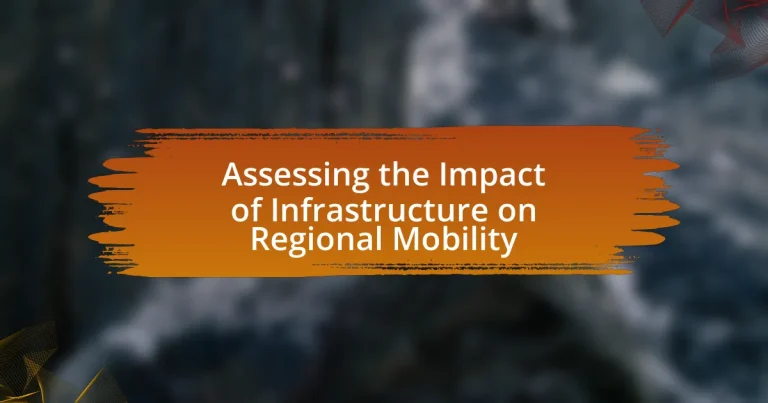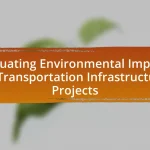The article focuses on assessing the impact of infrastructure on regional mobility, highlighting how well-developed transportation systems enhance efficiency, accessibility, and economic productivity. It discusses the critical role of various infrastructure types, such as roads, public transit, and pedestrian pathways, in shaping transportation options and influencing economic growth. Key factors in evaluating infrastructure’s impact include accessibility, connectivity, safety, and capacity, while demographic trends and ongoing assessments are essential for effective regional planning. The article also addresses challenges in data availability and stakeholder engagement, emphasizing best practices for comprehensive evaluations that can lead to improved mobility outcomes.

What is the Impact of Infrastructure on Regional Mobility?
Infrastructure significantly enhances regional mobility by improving transportation efficiency and accessibility. Well-developed roads, railways, and public transit systems reduce travel times and costs, facilitating the movement of people and goods. For instance, a study by the American Society of Civil Engineers indicates that every $1 billion invested in infrastructure creates approximately 13,000 jobs and boosts economic productivity, which directly correlates with increased mobility. Additionally, regions with robust infrastructure networks experience higher levels of connectivity, leading to greater economic opportunities and improved quality of life for residents.
How does infrastructure influence transportation options in a region?
Infrastructure significantly influences transportation options in a region by determining the availability, efficiency, and accessibility of various modes of transport. Well-developed roads, bridges, railways, and airports facilitate smoother and faster movement of people and goods, while inadequate infrastructure can lead to congestion, delays, and limited choices. For instance, regions with extensive public transit systems, such as subways and bus networks, provide residents with reliable alternatives to personal vehicles, thereby reducing traffic and emissions. Conversely, areas lacking such infrastructure often see a higher dependency on cars, which can exacerbate urban sprawl and environmental issues. Studies have shown that investments in transportation infrastructure can lead to increased economic activity, as seen in the 2016 report by the American Society of Civil Engineers, which highlighted that every dollar spent on public transportation generates approximately four dollars in economic returns.
What types of infrastructure are most critical for enhancing mobility?
Transportation infrastructure is most critical for enhancing mobility. This includes road networks, public transit systems, pedestrian pathways, and cycling infrastructure. For instance, a well-maintained road network facilitates efficient vehicle movement, while robust public transit systems, such as buses and trains, provide accessible alternatives to personal vehicles, reducing congestion. According to the American Society of Civil Engineers, investing in public transit can yield a return of $4 for every $1 spent, highlighting its effectiveness in improving mobility. Additionally, pedestrian and cycling infrastructure promotes non-motorized transport, contributing to healthier communities and reduced traffic.
How do different modes of transportation interact with infrastructure?
Different modes of transportation interact with infrastructure by utilizing specific facilities designed for their operation, such as roads for vehicles, tracks for trains, and runways for aircraft. Each mode requires tailored infrastructure to ensure efficiency and safety; for instance, highways accommodate high-speed vehicular traffic, while rail systems necessitate dedicated tracks and stations. The interaction is evident in the integration of multimodal transport hubs, which facilitate seamless transitions between modes, enhancing regional mobility. According to the Federal Highway Administration, effective infrastructure planning can improve travel times and reduce congestion, demonstrating the critical relationship between transportation modes and infrastructure.
Why is assessing infrastructure important for regional development?
Assessing infrastructure is crucial for regional development because it directly influences economic growth, social equity, and environmental sustainability. Infrastructure, such as transportation networks, utilities, and communication systems, facilitates trade, enhances accessibility, and improves the quality of life for residents. For instance, a study by the World Bank indicates that every 1% increase in infrastructure investment can lead to a 1.5% increase in economic output. Furthermore, effective infrastructure assessment helps identify gaps and prioritize investments, ensuring that resources are allocated efficiently to support regional needs and foster sustainable development.
What role does infrastructure play in economic growth and accessibility?
Infrastructure is crucial for economic growth and accessibility as it facilitates the movement of goods, services, and people. Efficient transportation networks, such as roads, railways, and airports, reduce travel time and costs, thereby enhancing trade and attracting investments. For instance, a study by the World Bank found that a 10% increase in road density can lead to a 1% increase in GDP, demonstrating the direct correlation between infrastructure development and economic performance. Additionally, improved infrastructure enhances accessibility to markets, education, and healthcare, which further contributes to human capital development and overall economic productivity.
How can infrastructure improvements lead to better quality of life for residents?
Infrastructure improvements can lead to better quality of life for residents by enhancing accessibility, reducing travel times, and increasing safety. For instance, the construction of new roads, public transit systems, and pedestrian pathways allows residents to reach jobs, schools, and services more efficiently. According to a study by the American Society of Civil Engineers, every $1 invested in public infrastructure generates approximately $3 in economic returns, which can improve local economies and create jobs. Additionally, improved infrastructure can reduce traffic congestion, leading to lower stress levels and better air quality, further contributing to residents’ overall well-being.
What are the Key Factors in Evaluating Infrastructure’s Impact on Mobility?
Key factors in evaluating infrastructure’s impact on mobility include accessibility, connectivity, safety, and capacity. Accessibility measures how easily individuals can reach destinations, while connectivity assesses the integration of different transport modes. Safety evaluates the risk of accidents and injuries associated with infrastructure, and capacity examines the ability of infrastructure to handle current and projected traffic volumes. Research indicates that improved infrastructure can lead to a 20-30% increase in mobility efficiency, highlighting the importance of these factors in planning and development.
How do demographic factors affect regional mobility assessments?
Demographic factors significantly influence regional mobility assessments by shaping travel patterns, transportation needs, and accessibility. For instance, age distribution affects mobility, as younger populations may rely more on public transit and active transportation, while older demographics might require more accessible options. Additionally, income levels correlate with vehicle ownership rates and the ability to afford transportation, impacting overall mobility. A study by the American Public Transportation Association found that low-income households are more likely to depend on public transit, highlighting how economic status affects mobility choices. Furthermore, population density and urban versus rural settings also play critical roles, as denser areas typically have more robust public transit systems, facilitating greater mobility.
What demographic trends should be considered in mobility studies?
Demographic trends that should be considered in mobility studies include population density, age distribution, income levels, and migration patterns. Population density influences transportation demand and infrastructure needs, as areas with higher density typically require more robust public transit options. Age distribution affects mobility preferences; for instance, younger populations may favor active transportation modes like biking, while older populations may rely more on accessible public transit. Income levels correlate with transportation choices, as lower-income individuals often depend on public transit due to limited access to personal vehicles. Migration patterns, including urbanization trends, impact regional mobility by altering demand for transportation services and infrastructure development. These trends are supported by studies such as the U.S. Census Bureau’s data on population shifts and the Federal Highway Administration’s reports on transportation trends, which highlight the relationship between demographic factors and mobility patterns.
How do population density and urbanization influence infrastructure needs?
Population density and urbanization significantly increase infrastructure needs by creating higher demand for transportation, utilities, and public services. As urban areas grow and more people inhabit them, the existing infrastructure often becomes inadequate, leading to congestion, insufficient public transport, and overburdened utilities. For instance, cities with high population density, such as Tokyo, require extensive public transit systems to accommodate millions of daily commuters, while urbanization trends in developing regions often lead to rapid informal settlements that lack basic services. This correlation is supported by studies indicating that urban areas with higher population densities experience greater strain on infrastructure, necessitating investment in expansion and modernization to ensure efficient mobility and service delivery.
What methodologies are used to assess the impact of infrastructure on mobility?
Quantitative and qualitative methodologies are used to assess the impact of infrastructure on mobility. Quantitative methods include traffic simulation models, which analyze traffic flow and congestion patterns, and travel demand forecasting models, which predict changes in travel behavior due to infrastructure changes. Qualitative methods involve surveys and interviews that gather user experiences and perceptions regarding infrastructure improvements. For instance, studies like the “National Cooperative Highway Research Program Report 770” provide empirical evidence on the effectiveness of these methodologies in evaluating infrastructure impacts on mobility.
What data sources are essential for accurate assessments?
Essential data sources for accurate assessments of infrastructure’s impact on regional mobility include traffic volume data, demographic information, land use data, and transportation network characteristics. Traffic volume data provides insights into current usage patterns, while demographic information helps understand the population’s needs and behaviors. Land use data reveals how different areas are utilized, influencing mobility patterns, and transportation network characteristics detail the existing infrastructure’s capacity and connectivity. These sources collectively enable a comprehensive analysis of how infrastructure affects regional mobility, supported by studies that demonstrate the correlation between traffic patterns and demographic shifts.
How can qualitative and quantitative methods be combined in evaluations?
Qualitative and quantitative methods can be combined in evaluations by integrating numerical data with contextual insights to provide a comprehensive understanding of the impact of infrastructure on regional mobility. For instance, quantitative data such as traffic counts and travel times can be analyzed alongside qualitative data from interviews or focus groups with commuters to uncover underlying reasons for travel behavior. This mixed-methods approach allows evaluators to validate findings, as seen in studies where quantitative metrics highlight trends while qualitative feedback explains the experiences behind those trends, enhancing the overall evaluation’s depth and accuracy.
What are the Challenges in Assessing Infrastructure’s Impact on Regional Mobility?
Assessing infrastructure’s impact on regional mobility faces several challenges, including data availability, measurement complexity, and the influence of external factors. Data availability is often limited, as comprehensive datasets on traffic patterns, public transport usage, and demographic changes are not always accessible or up-to-date. Measurement complexity arises from the need to evaluate multiple dimensions of mobility, such as travel time, accessibility, and user satisfaction, which can vary significantly across different regions and populations. Additionally, external factors like economic shifts, policy changes, and environmental conditions can confound the assessment, making it difficult to isolate the specific effects of infrastructure improvements. These challenges complicate the ability to draw clear conclusions about the relationship between infrastructure investments and regional mobility outcomes.
What common obstacles do researchers face in mobility assessments?
Researchers face several common obstacles in mobility assessments, including data availability, methodological challenges, and stakeholder engagement. Data availability is often limited due to privacy concerns, inconsistent data collection practices, and the lack of comprehensive datasets, which can hinder accurate analysis. Methodological challenges arise from the complexity of modeling mobility patterns and the need for interdisciplinary approaches, making it difficult to establish clear causal relationships. Additionally, engaging stakeholders such as local governments, transportation agencies, and community members can be challenging due to differing priorities and interests, which may affect the implementation of findings. These obstacles can significantly impact the effectiveness and reliability of mobility assessments.
How do funding limitations affect infrastructure evaluation studies?
Funding limitations significantly restrict the scope and depth of infrastructure evaluation studies. When financial resources are inadequate, researchers may be forced to reduce the number of sites assessed, limit data collection methods, or shorten the duration of studies, which compromises the comprehensiveness and reliability of the findings. For instance, a study by the National Cooperative Highway Research Program indicated that insufficient funding often leads to reliance on less rigorous methodologies, such as surveys instead of more costly longitudinal studies, which can result in biased outcomes. Consequently, the overall effectiveness of infrastructure investments in enhancing regional mobility may be misrepresented, leading to suboptimal policy decisions.
What are the implications of political and social factors on assessments?
Political and social factors significantly influence assessments by shaping the criteria and priorities used in evaluating infrastructure projects. For instance, political agendas can dictate funding allocations, leading to assessments that favor certain regions or projects over others, often based on electoral considerations rather than objective need. Social factors, such as community engagement and public opinion, can also affect assessments by highlighting specific local needs or concerns that must be addressed, thereby altering the focus of the evaluation process. Research indicates that regions with strong community advocacy often see more favorable assessments and funding outcomes, as seen in the case of urban development projects in cities like Portland, Oregon, where public input has led to successful infrastructure initiatives.
How can stakeholders collaborate to improve infrastructure assessments?
Stakeholders can collaborate to improve infrastructure assessments by establishing multi-disciplinary teams that include government agencies, private sector partners, and community organizations. This collaboration allows for the integration of diverse perspectives and expertise, which enhances the quality and comprehensiveness of assessments. For instance, the Federal Highway Administration emphasizes the importance of stakeholder engagement in its guidelines, stating that inclusive participation leads to more effective decision-making and better alignment with community needs. By sharing data, resources, and best practices, stakeholders can create a more accurate picture of infrastructure conditions and impacts, ultimately leading to improved regional mobility outcomes.
What roles do government, private sector, and community organizations play?
Government, private sector, and community organizations each play critical roles in shaping infrastructure and enhancing regional mobility. The government is responsible for planning, funding, and regulating transportation systems, ensuring that infrastructure meets public needs and safety standards. For instance, government agencies allocate budgets for road construction and maintenance, which directly impacts mobility efficiency.
The private sector contributes by investing in infrastructure projects, developing innovative technologies, and providing services that enhance transportation options. Companies like ride-sharing services and logistics firms improve mobility by offering flexible transportation solutions that complement public systems.
Community organizations advocate for local needs, ensuring that infrastructure development considers the voices of residents. They often engage in public consultations and mobilize community support for projects, which can lead to more inclusive and effective mobility solutions.
Together, these entities collaborate to create a comprehensive approach to infrastructure that supports regional mobility, as evidenced by successful public-private partnerships that have improved transit systems in various cities.
How can public engagement enhance the assessment process?
Public engagement can enhance the assessment process by incorporating diverse perspectives and local knowledge, which leads to more comprehensive evaluations. Engaging the public allows stakeholders to share their experiences and insights regarding infrastructure, resulting in a more accurate understanding of its impact on regional mobility. Research shows that projects with active public participation often yield better outcomes; for instance, a study by the National Cooperative Highway Research Program found that public involvement can improve project acceptance and effectiveness by up to 30%. This evidence underscores the value of public engagement in refining assessment methodologies and ensuring that they reflect community needs and priorities.
What are the Best Practices for Assessing Infrastructure’s Impact on Mobility?
The best practices for assessing infrastructure’s impact on mobility include comprehensive data collection, stakeholder engagement, and the use of performance metrics. Comprehensive data collection involves gathering quantitative and qualitative data on traffic patterns, public transport usage, and pedestrian activity to understand current mobility conditions. Stakeholder engagement ensures that the perspectives of local communities, businesses, and government agencies are considered, which can lead to more effective infrastructure planning. The use of performance metrics, such as travel time reliability, accessibility, and safety statistics, allows for a clear evaluation of how infrastructure changes affect mobility outcomes. These practices are supported by studies indicating that data-driven approaches lead to more informed decision-making and improved mobility solutions.
What strategies can be implemented for effective data collection?
Effective data collection strategies include utilizing surveys, leveraging technology for real-time data capture, and employing geographic information systems (GIS). Surveys can gather qualitative and quantitative data directly from users, providing insights into mobility patterns and infrastructure usage. Technology, such as mobile applications and sensors, enables the collection of real-time data on traffic flow and public transport usage, enhancing the accuracy of the information gathered. GIS allows for spatial analysis of data, helping to visualize and understand the impact of infrastructure on regional mobility. These methods are supported by studies indicating that comprehensive data collection improves decision-making in urban planning and infrastructure development.
How can ongoing assessments be integrated into regional planning efforts?
Ongoing assessments can be integrated into regional planning efforts by establishing a continuous feedback loop that informs decision-making processes. This integration involves regularly collecting and analyzing data on infrastructure performance, mobility patterns, and community needs, which allows planners to adapt strategies in real-time. For instance, the use of Geographic Information Systems (GIS) can facilitate the visualization of data trends, enabling planners to identify areas requiring immediate attention or improvement. Additionally, incorporating stakeholder input through public engagement initiatives ensures that assessments reflect the needs and priorities of the community, thereby enhancing the relevance and effectiveness of planning efforts. This approach is supported by studies indicating that regions employing adaptive management strategies, which include ongoing assessments, experience improved mobility outcomes and more efficient resource allocation.


